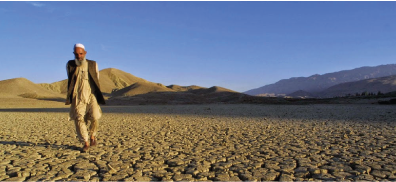
Article by
Pakistan faces some of the highest disaster risk levels in the world, ranked 18 out of 191 countries. This risk ranking is driven particularly by the nation’s exposure to earthquakes and the risks of internal conflict. However, Pakistan also has high exposure to flooding (ranked jointly 8th), including, riverine, flash, and coastal, as well as some exposure to tropical cyclones and their associated hazards (ranked jointly 40th) and drought (ranked jointly 43rd). Disaster risk in Pakistan is also driven by its social vulnerability. Pakistan’s vulnerability ranking (37th) is driven by its high rates of multidimensional poverty. Pakistan scores slightly better in terms of its coping capacity (ranked 59th).
Climate Change Impacts
Water
While increases in the severity of extreme events of both flood and drought seem likely, there is some uncertainty regarding the long-term outlook for water resources in Pakistan. Uncertainty surrounds projections of change in annual rainfall, some shifts in seasonality seem likely. In the context of Pakistan’s heavy reliance on the Indus Basin for its water resource, the uncertainty around future glacial change is significant. The impact of climate change on the Karakoram glaciers has been the subject of debate, with some studies suggesting glaciers have been increasing in size due to increased winter rainfall. However, a review conducted by UNDP shows shortcomings in these studies, particularly related to the lack of a comprehensive inventory of Upper Indus Basin glaciers. In addition, it suggests that in the shorter-term the climate change impact on water resources in Pakistan may be of lesser significance in comparison with the issues presented by growing human demand for water and other issues including the poor efficiency of Pakistan’s irrigation and water storage systems. However, UNDP emphasizes the strong likelihood that longer-term temperature rises will result in glacial loss, and reductions in the runoff which feeds the Indus, as well as changes to its seasonal profile. The extent to which changes in rainfall might offset this loss is uncertain.A researcher provided a useful overview of the potential impacts of climate change in the Indus Basin. Issues highlighted include the declining and insufficient capacity of Pakistan’s reservoirs to serve its needs under future development and climate change scenarios, and the likely pressure this will place on groundwater. Pakistan’s mountain regions also hold vulnerability to glacial lake outburst floods, triggered when ice melt and moraine failure releases large volumes of water trapped at high altitudes. With an uncertain future for glaciers in and neighbouring Pakistan, including temperature rises and changes in the precipitation regime, there is a need for further research and precautionary disaster risk reduction measures
Land and Soil
Issues of land degradation, desertification and dryland expansion are a major concern in Pakistan. Around 80% of Pakistan’s area is arid or semi-arid, processes linked to human development such as overgrazing, over-exploitation of water resources and over-cultivation, and excessive use of fertilizers are combining to degrade land quality and expand drylands. The Ministry of Climate change reports on the challenges Pakistan has faced in implementing the National Action Programme to Combat Desertification.A Researcher suggested there is significant potential for climate change to drive an increase in the land categorized as hyper-arid (the driest category) under higher emissions pathways. This phenomenon has already been documented in some regions, as droughts become more frequent in arid and semi-arid areas. Potential impacts of the expansion of drylands and desertification include the sedimentation of reservoirs, generation of dust storms, and loss of biodiversity. Initiatives such as “Clean Green Pakistan” aim to restore Pakistan’s natural environment, including through major tree planting efforts over the period 2016–2021.
Agriculture
Climate change will influence food production via direct and indirect effects on crop growth processes. Direct effects include alterations to carbon dioxide availability, precipitation and temperatures. Indirect effects include impacts on water resource availability and seasonality, soil organic matter transformation, soil erosion, changes in pest and disease profiles, the arrival of invasive species, and decline in arable areas due to the submergence of coastal lands and desertification. On an international level, these impacts are expected to damage key staple crop yields, even on lower emissions pathways. A research group estimate 5% and 6% declines in global wheat and maize yields respectively even if the Paris Climate Agreement is met and warming is limited to 1.5°C. Shifts in the optimal and viable spatial ranges of certain crops are also inevitable, though the extent and speed of those shifts remains dependent on the emissions pathway. A further, and perhaps lesser appreciated influence of climate change on agricultural production is through its impact on the health and productivity of the labor force. Work by Dunne A foreign researcher suggests that labor productivity during peak months has already dropped by 10% as a result of warming, and that a decline of up to 20% might be expected by 2050 under the highest emissions pathway. In combination, it is highly likely that the above processes will have a considerable impact on national food consumption patterns both through direct impacts on internal agricultural operations, and through impacts on the global supply chain.
 Monthly "Azeem English Magazine", launched in 2000, records the information about diverse fields like mental health, literature, research, science, and art. The magazine's objective is to impart social, cultural, and literary values to society.
Monthly "Azeem English Magazine", launched in 2000, records the information about diverse fields like mental health, literature, research, science, and art. The magazine's objective is to impart social, cultural, and literary values to society.
+92 51 88 93 092
First Floor, RAS Arcade, Eidhi Market, Street#124, G-13/4, Islamabad, Pakistan, 44000.